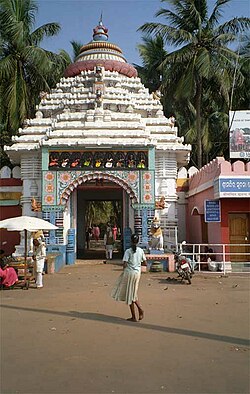| This article is part of a series on |
| Odisha |
|---|
 |
| Governance |
| Topics |
| Districts Subdivisions |
| GI Products |
This article lists monuments and sites of historic importance in Odisha, India.
| This article is part of a series on |
| Odisha |
|---|
 |
| Governance |
| Topics |
| Districts Subdivisions |
| GI Products |
This article lists monuments and sites of historic importance in Odisha, India.
| Site | Date(s) | Picture | Location | Description | References |
|---|---|---|---|---|---|
| Gudahandi | c. 20000 BCE | Kalahandi district | Rock paintings from Upper Paleolithic. | ||
| Vikramkhol | c. 3000 BCE | Jharsuguda | Prehistoric human rock shelter with inscriptions. | [1] |
Singhapura (In Jajpur Dist): Some historians said that it was the capital of Singha Bahu, a Kalinga King who was contemporary of Lord Buddh and Bimbisar of Rajgrih. His exiled son Prince Vijaya established Sinhalese dynasty in Sri Lanka. The Archaeological Survey of India has been requested to excavate this site to unravel the truth.
| Site | Date(s) | Picture | Location | Description | References |
|---|---|---|---|---|---|
| Dhauli | 262 BCE |  | Dhauli, Bhubaneswar | Site of the Kalinga War | [2] |
| Sisupalgarh | c. 300 CE |  | Bhubaneswar 20°13′35.9″N85°51′11.0″E / 20.226639°N 85.853056°E | Ancient fort | [3] |
| Asurgarh | c. 9th century BCE | Kalahandi | Asurgarh is an archaeological site in the Kalahandi district of Odisha, India. Asurgarh is one of the sites which has its beginning in around 8th-9th century BC and emerged as one of the early urban fortified settlements in the region and it is older than Sisupalgarh. Archaeologists have unearthed artefacts believed to be 2,300-year-old while carrying out excavation at the Asurgarh Fort in Odisha’s Kalahandi district. DB Gadanayak, Archaeological Survey of India, says Asurgarh is one of the sites which has its beginning in around 8th-9th century BC and emerged as one of the early urban fortified settlements in the region by the efforts of tribal and non-tribal inhabitants of the region. [4] Lokesh Durga, Department of History of Delhi University, says Asurgarh settlement is older than Sisupalgarh and the first Urbanization process in Odisha started from Asurgarh. [4] [5] [6] | [7] [8] | |
| Bindusagar Tank | c. 7-8th century CE |  | Old Town, Bhubaneswar | A ritual tank with a shrine in the centre. | [9] |
| Chausath Yogini Temples | c. 9th century CE |  | Jharial, Bolangir | A hypaethral temple for 64 yoginis | [10] |
| Chausathi Jogini Temple | 9th century CE |  | Hirapur, Khurda | Hypaethral temple for 64 Yoginis in the outskirts of Bhubaneswar | [11] |
| Anantashayana Vishnu | 9th century CE | Sarang, Dhenkanal | 15 metre long rock cut image of Vishnu lying in rest. | [12] |
| Site | Date(s) | Picture | Location | Description | References |
|---|---|---|---|---|---|
| Ratnagiri | c. 10th century |  | Jajpur | Buddhist monastery built by the Bhauma-Kara dynasty | [13] |
| Lalitgiri | c. 10th century |  | Cuttack | A group Buddhist monasteries. | [14] |
| Brahmeswara Temple | 1058 CE |  | Bhubaneswar | Shiva temple built during reign of the Somavamsis | [15] |
| Jagannath Temple | c. 1090 |  | Puri | Vaishnava temple built by Eastern Ganga dynasty kings. | [16] |
| Lingaraja Temple | c. 1100 |  | Bhubaneswar | Shiva temple built by Somavamsi kings. | [17] |
| Gundicha Temple | 12th century |  | Puri | Built by the Eastern Ganga dynasty. Houses the main idols during the Ratha Yatra festival. | [18] [19] |
| Barabati fort | c. 1230 |  | Cuttack | Presumed to have been built by Anangabhimadev III of the Eastern Ganga dynasty | [20] |
| Kapilash Temple | 1246 |  | Dhenkanal | Shiva temple constructed by Narasingha Deva I. | [21] |
| Konark Sun Temple | c. 1250 |  | Konark | Supposedly built by king Narasingha Deva I of Eastern Ganga Dynasty around 1250. | [22] |
| Ananta Vasudeva Temple | c.1278 |  | Bhubaneswar | Vaishnava temple built by Queen Chandrika, daughter of Anangabhimadeva III, of the Eastern Ganga dynasty | [16] [23] |
| Atharanala Bridge | c.1300 |  | Puri 19°49′11″N85°49′54.1″E / 19.81972°N 85.831694°E | Bridge with 18 arches, purportedly built by Narasingha Deva II of Eastern Ganga Dynasty. | [24] |
| Biraja Temple, Jajpur | 13th Century | Built originally by Jajati Keshari of Soma Dynasty | |||
| Annakoteshvara Temple | 16th Century | Latadeipur, Gondia, Dhenkanal | Shiva temple built during the reign of the Gajapati dynasty | [25] [26] | |
| Alarnath Temple | 1610 AD | Brahmagiri, Puri, 752011 | [27] | ||
| Baladevjew Temple | 1707 | Kendrapara | Temple built during Maratha occupation of Odisha. | [28] | |
| Qadam-e-Rasool | 1718 | Cuttack | Mosque built by Shuja-ud-Din Muhammad Khan. Purportedly contains a Qadam Rasul (footprint of Muhammad). | [29] |
| Site | Date(s) | Picture | Location | Description | References |
|---|---|---|---|---|---|
| Joranda Gadi | Early 20th century | Joranda, Dhenkanal | Contains the samadhi of the founder of the Mahima Dharma sect. | [30] | |
| Inchudi | 1930 | Balasore | Site of Salt Satyagraha in the state. | [31] |
{{cite book}}: ISBN / Date incompatibility (help)